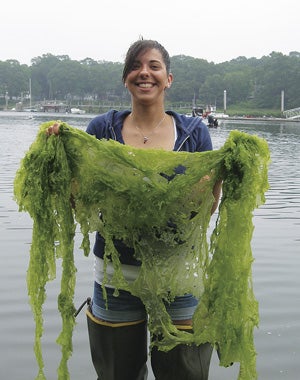Seaweed & Snails
 While seaweed is often considered an annoyance to most people, senior Emily Vincent believes that algae may be the key to her future career.
While seaweed is often considered an annoyance to most people, senior Emily Vincent believes that algae may be the key to her future career.
She spent a half-year researching the impact of snails on populations of seaweed in Greenwich Bay.
“I never knew how complex algae is,” the marine biology major says. “It was so interesting to learn about its different life cycles and its cell structure.”
Her research project, sponsored by the URI Coastal Fellows program, was in collaboration with URI Associate Professor Carol Thornber and graduate student Michele Guidone.
Vincent sought to learn whether common mud snails that graze on seaweed in the genus Ulva keep the seaweed under control or whether the snails facilitate its growth. She visited beaches around Greenwich Bay almost daily and collected seaweed, some of which was taller than she is, and placed it in large tanks at the Graduate School of Oceanography, where she conducted feeding trials.
“Macro algae blooms are bad for coastal communities, causing fish kills and harming ecosystems and recreational uses of the coastline,” Vincent said. “Herbivores like snails can exert top-down control of the blooms, but we wanted to know which species they prefer to eat.”
Vincent found the snails didn’t eat the Ulva at all. Instead, they grazed on the microscopic diatoms sitting atop the blades of seaweed. To learn more results go to uri.edu/news/releases/index.php?id=5161.
“We still have a lot more questions, but what we found was certainly not what we expected,” said Vincent, who hopes to continue the study this summer before enrolling in graduate school.
 Home
Home Browse
Browse Close
Close Events
Events Maps
Maps Email
Email Brightspace
Brightspace eCampus
eCampus


